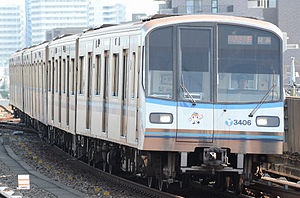Yokohama Subway Blue Line
| Yokohama Municipal Subway Blue Line | |
|---|---|

A 3000R series train on the Blue Line in July 2015
|
|
| Overview | |
| Native name | 横浜市営地下鉄ブルーライン |
| Type | Rapid transit |
| System | Yokohama Municipal Subway |
| Locale | Yokohama |
| Termini |
Shōnandai Azamino |
| Stations | 32 |
| Daily ridership | 513,897 (FY2014) |
| Line number | 1 & 3 |
| Operation | |
| Opened | December 16, 1972 |
| Owner | Yokohama Municipal Subway |
| Depot(s) | Kaminagaya, Nippa |
| Rolling stock | 3000 series |
| Technical | |
| Line length | 40.4 km (25.1 mi) (Line 1: 19.7 km, Line 3: 20.7 km) |
| Track gauge | 1,435 mm (4 ft 8 1⁄2 in) |
| Electrification | 750 V DC, third rail |
| Operating speed | 80 km/h (50 mph) |
The Yokohama Municipal Subway Blue Line (横浜市営地下鉄ブルーライン? Yokohama Shiei Chikatetsu Burū Rain) is a 40.4 km (25.1 mi) line in the Yokohama Municipal Subway system of Yokohama, Japan, operated by Yokohama City Transportation Bureau. Line 3 runs from Azamino to Kannai, and Line 1 runs from Kannai to Shōnandai. All trains operate over both lines. This is the second-longest subway line in Japan at 40.4 km after the 40.7 km long Toei Oedo Line in Tokyo.
As of 1 April 2016[update], the line is operated using a fleet of 37 six-car 3000 series EMUs based at Kaminagaya Depot. The fleet is subdivided into eight first-batch 3000A series sets (numbered 24 to 31), seven second-batch 3000N series sets (numbered 32 to 38), fourteen third-batch 3000R series sets (numbered 39 to 52), and eight fourth-batch 3000S series sets (numbered 53 to 60).
A fifth-batch 3000V series six-car set entered service on the line on 9 April 2017, with a total of seven sets scheduled to be introduced by 2022, replacing the earlier 3000A series trainsets.
3000A series set 30 in September 2010
3000N series set 32 in September 2010
3000R series set 46 in September 2010
3000S series set 58 in September 2010
3000V series set 61 in April 2017
Preserved 1000 series EMU set 01 in October 2014
2000 series set 15 in March 2004
The first section of the line opened between Isezakichōjamachi and Kami-Ōoka on December 16, 1972. The subsequent progress of the line was as follows:
From July 2015, limited-stop "Rapid" services were introduced on the line, with approximately two services operating per hour during the daytime off-peak. Journey times over the entire length of the line were reduced by up to 10 minutes from the 1 hour 7 minutes taken by all-stations services.
...
Wikipedia
